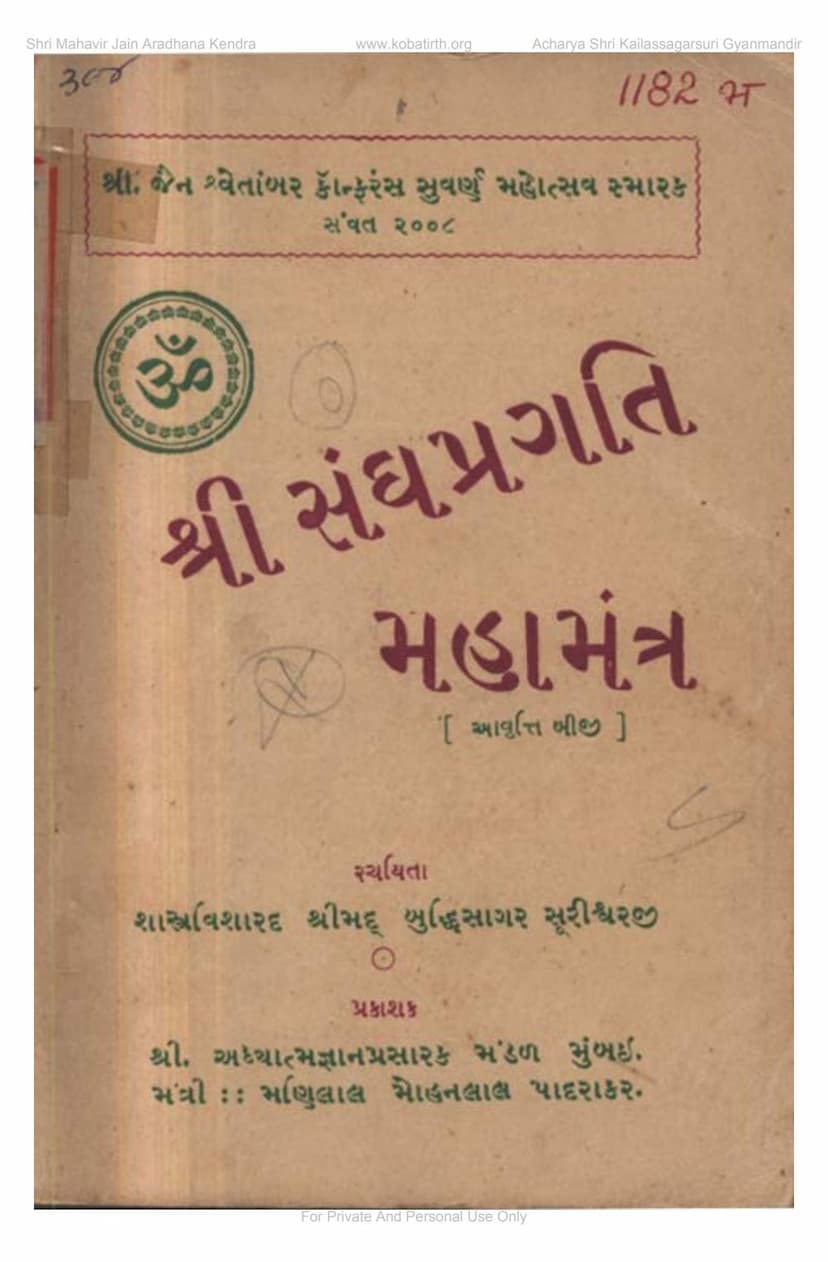Sanghpragati Mahamantra
Added to library: September 2, 2025

Summary
Here's a comprehensive summary of the Jain text "Sanghpragati Mahamantra" by Buddhisagar, based on the provided pages:
Title: Sanghpragati Mahamantra (The Great Mantra for Sangha Progress) Author: Shrimad Buddhisagar Surishwarji Publisher: Shri Adhyatmagyan Prasarak Mandal, Mumbai Second Edition: Vikram Samvat 2008 (1952 CE)
Core Message and Purpose:
The book "Sanghpragati Mahamantra" is a profound treatise advocating for the unity, progress, and revival of the Jain community (Sangha). It emphasizes the critical need for adherence to the guidance of contemporary Jain Acharyas, re-evaluation of practices in light of current times, and the collective responsibility of all Jains – monks, nuns, and householders – to strengthen the Jain faith spiritually, socially, economically, and culturally. The text was published to coincide with the Golden Jubilee of the Shri Jain Conference, aiming to inspire and guide the Sangha towards progress.
Key Themes and Arguments:
-
The Primacy of Present-Day Acharyas: The book strongly argues that while the teachings of past Acharyas are venerable, the current era requires the active guidance and decrees of living, knowledgeable (Geetarth) Acharyas. It draws an analogy to governance, stating that ignoring current rulers in favor of past ones leads to the collapse of authority. Therefore, following the directives of contemporary Acharyas, who are seen as the true representatives of Lord Mahavir's teachings for the present age, is essential for the Sangha's progress.
-
The Need for Unity and Overcoming Differences: The author laments the decline in the Jain population and the lack of unified action, attributing it to petty differences and sectarian disputes. The text calls upon all three sects of Jainism (Digambara, Shvetambara, and others, implicitly) to set aside minor disagreements and work together for the advancement of Jainism.
-
The Role of the Acharya as the Head of the Sangha: The book portrays the Acharya as the "head" of the Jain community, analogous to the brain guiding the body. It stresses that all members of the Sangha must follow the Acharya's directives for the well-being and progress of Jainism. The analogy of a disciplined army or a well-governed state is used to highlight the importance of a central authority and structured adherence to rules.
-
The Four Pillars of Jain Dharma: The text identifies Dana (charity), Sheel (virtue/conduct), Tap (penance), and Bhavna (meditation/contemplation) as the four foundational pillars of Jain Dharma. It emphasizes that the unity and strength of the Sangha depend on the robust foundation of these pillars in all its members.
-
The Responsibility of the Four-Fold Sangha (Chaturvidh Sangha): The book meticulously outlines the duties and responsibilities of monks (Sadhus), nuns (Sadhvis), laymen (Shravakas), and laywomen (Shravikas). It advocates for a structured approach to religious and social work, with Acharyas at the helm, guiding and organizing the efforts of all.
-
Addressing the Decline of the Jain Community: A significant portion of the book is dedicated to analyzing the reasons for the decline in the Jain population from approximately 400 million in the past to around 13 million in the present. The author points to a lack of unified effort, internal conflicts, and a decline in the effectiveness of preaching and propagation as major contributing factors.
-
Reforms and Modernization: The text advocates for adapting Jain practices and organizational structures to suit the modern era. It calls for the establishment of educational institutions for monks and nuns, structured training programs, and a unified approach to spreading Jain teachings, drawing inspiration from the efficiency seen in other global communities and religions.
-
The Importance of Knowledge and Education: The book stresses the crucial role of knowledge and education for both the spiritual and practical upliftment of the Sangha. It highlights the need for learned Acharyas, monks, and nuns who can effectively impart religious knowledge and also for the laity to pursue education for overall progress.
-
Emphasis on Unity and Collective Action: The central "Mahamantra" of the book is unity and collective action. It repeatedly calls for Jains to overcome internal divisions, foster mutual respect, and work together harmoniously for the common good of the Sangha and the preservation of Jain principles.
-
Practical Suggestions for Sangha Progress: The book provides numerous practical suggestions, including:
- Establishing a strong organizational structure for the Sangha, guided by Acharyas.
- Creating educational institutions for monks and nuns.
- Developing systematic plans for preaching and propagation of Jainism.
- Encouraging unity among different Gachhas (sects/orders).
- Promoting inter-community dialogue and cooperation.
- Emphasizing the importance of virtues like tolerance, humility, and selfless service.
- Encouraging Jains to contribute financially and intellectually towards Sangha activities.
- Focusing on population growth and conversion efforts.
- Recommending adherence to the timely and contextually appropriate teachings of Acharyas.
Overall Tone and Significance:
The "Sanghpragati Mahamantra" is a passionate and urgent call to action for the Jain community. It is written with a deep sense of concern for the current state of the Sangha and a strong desire for its revival and progress. The author's scholarly approach is evident in his deep understanding of Jain scriptures and his ability to apply their principles to contemporary challenges. The book serves as a foundational text for those seeking to understand and contribute to the well-being and advancement of the Jain faith.